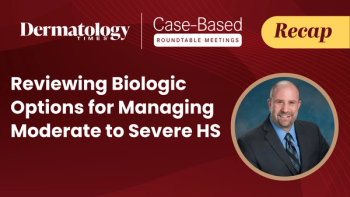
Revolutionizing GPP Recognition Through Data Collection
This Rare Disease Day, Stefan Weiss, MD, MBA, FAAD, of OM1, shares his expertise in AI’s capabilities in dermatology.
Rare Disease Day has been observed globally every year on the last day of February since its creation in 2008. This year, Rare Disease Day is observed on February 29, and it is an opportunity to work toward increased awareness.
One of the emerging methods for further studying, analyzing, and detecting rare diseases and their characteristics is through artificial intelligence (AI).
Stefan Weiss, MD, MBA, FAAD, the managing director of dermatology at
"In medicine, there is hesitancy around AI because of the concern that the 'machine will take over from the human. Because AI sees patterns more rapidly, it has been highly leveraged in pathology and radiology. Despite the visual nature of dermatology, there remains the need in dermatology to understand the whole patient... Thus, AI is not there to take over the role of the clinician, but rather to help and improve patient care," said Weiss.
Transcript
Dermatology Times: Can you please explain the partnership between AAD’s DataDerm and OM1’s Patient Finder for the improved diagnosis and treatment of GPP?
Weiss: The American Academy of Dermatology’s (AAD) DataDerm is the largest single registry of dermatology patients in the country, which forms the foundation for any data analysis that can be done within dermatology at OM1. OM1’s Patient Finder, in its purest form, is the ability to identify individuals who may suffer from a disease but lack awareness that they carry it. As such, it can identify an individual who may not present with the disease until later in life. Patient Finder can also identify individuals who may perform better or worse on a certain therapeutic in terms of either efficacy or safety. As it relates to generalized pustular psoriasis (GPP), deploying Patient Finder was an opportunity to focus on individuals who have a rare disease, GPP, that often goes undiagnosed or misdiagnosed for a very long time.
For background on GPP, these individuals tend to present with pustules all over their body. As many do not know to see a dermatologist, they will often find themselves in urgent care or in the emergency department, which could spiral into a hospital admission and extensive use of antibiotics. Identifying in advance those individuals who may carry GPP offers the opportunity to be more proactive about care delivery, either connect with a dermatologist proactively or at least recognizing that should a flare occur, informing the rendering provider that neither hospitalization nor extensive antibiotic use is necessary. The partnership between OM1’s Patient Finder and AAD’s DataDerm for GPP is really an opportunity to drive improvements in patient care.
Dermatology Times: Are there future opportunities for OM1's Patient Finder to be used in other partnerships or dermatologic conditions?
Weiss: There are some dermatologic diseases that we all can recognize from 100 yards away. However, many are hard to distinguish, especially for the non-dermatologist. Recognizing the individuals who are more likely to carry and present with a certain disease can be extremely helpful. The best example of another dermatologic condition for which Patient Finder would be useful is hidradenitis suppurativa (HS), a disease where cysts form under the breasts, in the groin, or under the arms. When these cysts form as a one-off, individuals often find themselves in a primary care office. Women quite frequently go to their gynecology clinic. Many patients visit urgent care to have the cysts lanced. However, cyst removal is not going to treat the underlying condition. If we can identify in advance those individuals as suffering from HS, we are better able to connect them to the health care system for appropriate treatment.
Dermatology Times: In your opinion, what are some of the top challenges of accurately and quickly diagnosing GPP?
Weiss: One of the main challenges of diagnosing and treating GPP is finding physicians who recognize the disease. GPP is a rare disease and like all rare diseases, it is quite infrequently seen by even by the specialists who may treat it. By leveraging large datasets to identify carriers of the disease, those individuals can be better managed.
Dermatology Times: With Rare Disease Day in mind, what is the role of AI in improving the lives and outcomes of patients with rare diseases such as GPP?
Weiss: Rare diseases, dermatologic or otherwise, are rare, and therefore hard to recognize, diagnose, and treat. If we can use AI for identification, we can improve the care that those people receive.
Dermatology Times: AI is a constant buzzword in medicine and in media. How can clinicians trust OM1's Patient Finder and other tools as another AI platform?
Weiss: In medicine, there is hesitancy around AI because of the concern that the “machine” will take over from the human. Because AI sees patterns more rapidly, it has been highly leveraged in pathology and radiology. Despite the visual nature of dermatology, there remains the need in dermatology to understand the whole patient. A single picture of a red itchy plaque on the elbow may be eczema, it may be psoriasis, it may be fungal-related. In the end it can be the manifestation of many different diseases. It is challenging for the machine to make that determination without having greater context. Thus, AI is not there to take over the role of the clinician, but rather to help and improve patient care.
If AI can determine that patient X would do better on drug A than drug B in terms of either safety or efficacy, then it is a valuable tool in finding the right patient the right drug at the right time. That is the way AI should always be regarded within the clinical arena.
[Transcript lightly edited for space and clarity]
Newsletter
Like what you’re reading? Subscribe to Dermatology Times for weekly updates on therapies, innovations, and real-world practice tips.


















